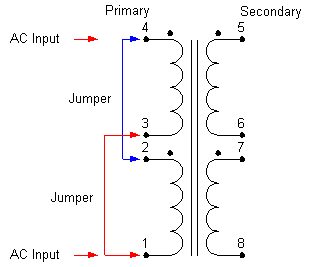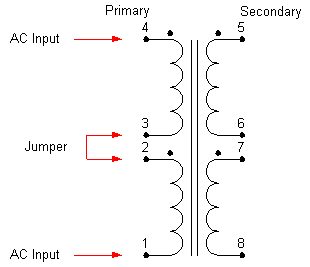Hermes Free Energy Transformers

Parallel Input 2*230 Volt 2*1 Ampere = 2*230 Watt

Serial Output 230 Volt*1 Ampere+1 Volt*230 Ampere =
231 Volt*231 Ampere = 53361 Watt

Serial Input 2*115 Volt 2*1 Ampere = 2*115 Watt

Serial Output 115 Volt*1 Ampere+1 Volt*115 Ampere =
116 Volt*116 Ampere = 13456 Watt
More parallel and serial windings
Dual Voltage Transformers
 Transformer Phasing: The Dot Notation and Dot Convention
Transformer Phasing: The Dot Notation and Dot Convention
Instead of using one transformer with two input windings and two output
winding use two tranformer with two identical primary windings and two different
secondary windings.
That is the theoretical way to free energy
- Hermes Atar Trismegistus
Hi Hermes,
I've been
working with transformers for
a long time, maybe somewhere around 45 years. No matter how you connect the coils,
they don't produce more energy out than you put into them - there's simply nowhere for
that energy to come from.
As far as we can tell, energy is a fixed resource in
the universe. We can't make it, and we can't destroy it, so if we want to get energy
out of something there has to be a source of that energy. For most things we convert
mass to energy by burning stuff. We can also convert it from one form to another.
Exothermic reactions (burning stuff for example) convert mass to energy, but
endothermic reactions convert energy to mass. The conversion factor is E=mc˛.
Most people, when they think of Free Energy, try to produce energy from *nothing*, and
that's what most of the ideas you put on your website are trying to do. It's why they
don't actually work, since energy is conserved. There is however a load of energy all
around us, but we can't use it to do work because it's in random directions. In order
to do useful work, we need that energy to be moving in one direction and then we can
change that direction at will to shift something from *here* to *there*.
Instead of trying to create new energy, which appears to really be impossible to do,
it's better to concentrate on how we can change the random energy we have (for example
environmental heat) so it moves in one direction. That is actually possible - a solar
cell takes in light energy in random directions and puts out electrical energy in a
single direction. There are other proven ways of doing this as well, but so far they
have only been a low power level because it is believed that this is impossible
because of the 2LoT. This seems to blind people to the evidence that those devices
actually do work, and that they need to be improved in order to be useful sources of
power.
There are two tendencies in action. The tendency to disorder is
well-known - shake something up and it becomes less ordered, or shuffle a pack of
cards and they will become more random. Force fields on the other hand impose order -
drop an apple and it will go downwards and not up or in a random direction. Electrons
move one way in an electric field. Somehow that tendency to order is used in many ways
but it is not seen that if we can make the field strong enough then we produce more
order than disorder and that the direction of energy can be de-randomised. The example
of the solar cell, which obviously works, is not seen as de-randomising the incoming
energy, though that is precisely what it is doing. The principle of producing real and
working Free Energy is thus not noticed by most people, even when it has been
explained. We don't need to produce new energy, just re-use the energy we already
have.
Yep,
Rossi has
nothing.
I can't see how so many people seem to ignore the
bad measurements,
but
Hope can blind people.
I'm glad you're not fooled. There's still a chance that
Brillouin really has a working system even
though their theory is wrong, and that
BrLP may also have
something that works despite their theory being wrong too. The replication of
Miles' heat-/Helium correlation
should prove that LENR works and is nuclear,
but that won't be commercially useful. May take a while before people work out why it
happens, which is needed before it has a chance of being commercially useful.
Best regards, Simon
The following data is the measure of
Andrea Rossi's
E-Cat QX
DATA REPORT OF THE MEASUREMENTS MADE ON NOVEMBER 24TH 2017 ON THE E-CAT QUARKX
TESTED AT THE IVA, GREV TUREGATAN 16, STOCKOLM, SWEDEN.
Duration of the measurement period: 1 hour: the measurement has been made after the
apparatus has reached a reasonably constant temperature amount of water pumped through
the reactor: 1 000 g
Water temperature at the input of the reactor: 21 C
Water temperature at the output of the reactor: 41 C
Delta T: 20 C
Energy produced: 20 x 1.14 = 22.8 Wh/h
Measurement of the energy
consumed (during the hour for 30' no energy has been supplied to the E-Cat) :
V: 0.3
OHM: 1
A: 0.3
Wh/h 0.09/2= 0.045
Ratio between
Energy Produced and energy consumed: 22.8/0.045 = 506.66
Instrumentation used
for the measurements: Oscilloscope Tektronix TBS 1052B
K probes Omega supplied
and calibrated by Prof. Bo Hoistad of the University of Uppsala
Water pump
Prominent. The water pumped for 1 hour has been poured in a plastic container seat on
a scale to measure exactly the water passed through the E-Cat.
Temperature Data Logger: PICO Technology
The scale to weight the water passed through the E-Cat has been supplied by Eng. Mats
Lewan of Stockolm
William S. Hurley
Senior Engineer- Endeavor
Los Angeles
The claimed COP of the E-Cat QX is >550. But that is not true.
The energy produced by the E-Cat QX was 22.8 Watt but the maximum output from
the controller was 50 watt and cooled by a 10 watt fan? making a total input power of
60 watt as you can see from
Mats Lewan Slides of Test Protocol.
So the Ratio between Energy Produced and energy consumed: 22.8/60=0.38.
As you
can see, there is no need to invest in
Andrea Rossi's
E-Cat QX
for the moment, until he figure out how to improve the controller so it draws less
watt. In the meantime you can support my
free energy research. I have built a
high freqency transformer that is less than 100% effective, but my goal is overunity.
- Hermes Atar Trismegistus
Hi Hermes,
I think your
theory is incorrect. Use better theory of transformers that actually describes what is
going on. Read this transformer theory and the history behind it:
https://wiki2.org/en/Transformer.
Transformers act according to natural laws. There are many models describing
transformers depending on what they're used for.
Read Kirchhoff's current law:
https://wiki2.org/en/Kirchhoff's_circuit_laws#Kirchhoff.27s_current_law_.28KCL.29
Current transformer (shorted or heavy loaded secondary):
https://wiki2.org/en/Current_transformer
Article describing the difference between voltage and current transformers:
https://www.quora.com/What-is-a-voltage-transformer-and-a-current-transformer
Regards
Ole
Hi Hermes,
There are so many other places to
read (and comment) about Rossi that I don't see a lot of point putting an article up
at R-G. You've seen that there's obviously
more power being used than was measured as output, and the puzzle is why some people
don't see that point. Much the same as the 2011 demo where a 500kW Diesel generator
was running throughout and the power produced was shown to be 470kW when it was billed
as supposed to be 1MW.
Basically, Rossi is all about smoke and mirrors and I
don't see anything anomalous there, except that people who ought to be more discerning
aren't.
Of course, there's always that hope that Free Energy claims could be
true. There is good evidence that
Pd/D LENR works (and
that should be confirmed again fairly soon) and the Thermacore data implies that
there's a good chance of
Ni/H LENR
being real as well. I think Brillouin are telling the truth, but so far they've got a
few watts and can't self-run. I can't predict when or if they'll come out with
something commercially useful.
As I've said before, the bottom line is really
how much it costs us to get the energy. What is the cost of the device, how long does
it last and what are the running costs? How much does it cost you per joule or per
kWh? Currently, electricity wholesale cost is around 5 US cents or 5 UK pence per kWh,
so that's the number you need to beat however you do it. Getting that power to the end
user costs around the same amount in some places, though in some locations we find the
transmission costs are a lot higher or the base generation costs are a lot higher (for
example if you need a Diesel generator and are a long way from the source of that
fuel). As such, in some places a power source that costs $1 per kWh may be viable. The
cheaper you can get it, though, the more places it will be competitive with other ways
of getting the power.
The strategy is thus to look for energy-flows we can
utilise (for example solar power, wind power, wave power, tidal power) and build
something to harvest them cheaply, or to create that energy-flow using a fuel and
burning it. Personally, I see environmental heat (which is a random flow of energy) as
able to be rectified into a unidirectional energy and thus be useful for doing work,
but of course this is a little difficult to actually make the device since it uses
thin-film fabrication methods. We'll see whether I'm successful at making something
fairly soon. On the other hand, trying to create energy from nothing seems to be not a
good strategy since that is most likely never going to be possible - if it was we'd
have seen some indications in cosmology or in one of the historical experiments that
tried to do this - lots of claims, but there's nothing extant that demonstrates it in
a way we can measure.
Best regards, Simon
back to linkpage
suggestion
read and sign my guestbook



